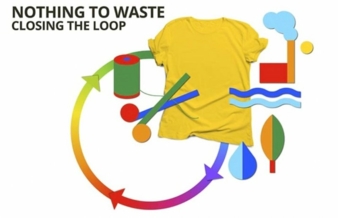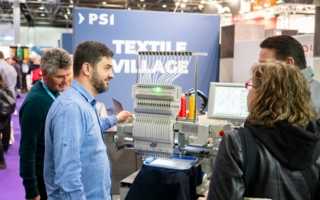07/10/2020 – Focus Topic: Nothing to Waste – Closing the Loop — auf Deutsch lesen
25. Performance Days: Stop wasting finite resources!
Finite resources and endless mountains of rubbish set the tone of the upcoming 25th edition of Performance Days.

The Performance Days trade fair has chosen a new Focus Topic that concerns not only our own industry. The textile industry has long been achieving more efficient production by recycling its own waste products and using recycled materials from outside the industry, for example, PET-bottles. © Performance Days
Closing the loop means nothing is wasted, not even time, as recycled clothing gets recycled again and again. In keeping with this topic, the trade fair organizers are planning expert discussion panels to help present the facts as well as visions of the future. Look for materials such as fibers from recycled PET bottles, recyclable mono-component materials or blends, and shirts that decompose to biomass in a “Cradle-to-Cradle” approach.
“Nothing to Waste – Closing the Loop” is open to the public at the Messe München fairgrounds and as a Digital Fair online starting on December 9–10, 2020.
The Performance Days trade fair has chosen a new Focus Topic that concerns not only our own industry. The textile industry has long been achieving more efficient production by recycling its own waste products and using recycled materials from outside the industry, for example, PET-bottles.
Nevertheless, textiles exist alongside glass, paper, metal, and plastics as a separate branch of waste management.
Despite ambitious efforts at recycling by the waste and textile industries, the efficient use of textile waste as a resource remains a challenge.
Compounding this challenge are the difficulties caused by a global world: production, consumers, and disposal sites are miles apart, shared expert knowledge about the other industries is lacking, and international standards and political support are nearly non-existent.
Final destination: the waste bin
Information from the Federal Office for the Environment shows that 0.8 percent of the oil produced is used in the textile industry for the production of new textiles. But the costly processing chain of this finite resource ends all too quickly in waste. A Greenpeace survey reveals outdated fashions or clothing of worn quality is thrown away within three years, only to land in the trash dumpsters. The European Environmental Agency estimates that 5.8 million tons of used textiles are discarded every year and either incinerated, used for landfill, or taken to mechanical-biological sewage treatment plants. Even if used clothing is collected by state or private companies, in many cases it cannot be sold (as second hand), donated, or recycled (into rags or insulating material). In the best case scenario, it is incinerated and converted to thermal energy.
Recycling and circular design
From an economic and environmental perspective, the term recycling refers to waste-free products, waste avoidance, and waste recovery and disposal. In our industry as it stands, recycling at the end of the product life cycle usually means converting the product into some other product, i.e., not clothing. This is the “Open-Loop” process. Accordingly, textiles are eventually incinerated, but the amount of energy recovered can vary greatly depending on how efficiently the waste incineration plant works. Such devaluing of the product to a product with less value than the original product is known as Downcycling. However, Downcycling is not the only solution: the “Closed-Loop” approach has the goal of making new clothes out of old ones through recycling. The closed loop for renewable natural resources, for example, can mean that natural fibers used in textiles will end up becoming soil, which is the nutrient for new natural fibers, i.e., a cradle-to-cradle approach. Synthetic garments similarly require extracting the man-made fibers and reprocessing them to produce another garment.
Planning for the end in advance
Rather than thinking about recycling opportunities at the end of the product life cycle, brands can already begin developing closed loop options while in the design phase. Among other things, designing out the waste can reduce the environmental impact of the products. To extend the useful life, consider leasing the materials and/or adding labels with instructions for disposal, repair, or repurposing. And, what about the idea of preparing 100 percent used textiles that can be reintroduced into the supply chain as 100 percent new textiles? Separating the different types of fiber used in blends is complex, cost-intensive, and further complicated when labels are non-existent (or no longer existing) or it is simply not (yet) technically possible. More and more clothing makers and suppliers are trying to avoid mixing fibers and are switching to “mono-materials” or “mono-components”. Shirts are easy to make in this way, but if you add buttons, zippers etc., the issue becomes more complex.
Nothing to waste – not even time
If you are like many end consumers, brand managers, and producers and want to make use of valuable resources in a more sustainable manner, register now on the trade fair website under “Visitor Login”. There you can access a free trade fair ticket for December 9-10, 2020. You can also learn about the complimentary and soon to be expanded offers at the Digital Fair.
Perfomance Days / Digital Fair Trends
• 9.–10. December 2020 Munich, Germany
• 9.–10. December 2020 Digital Fair



